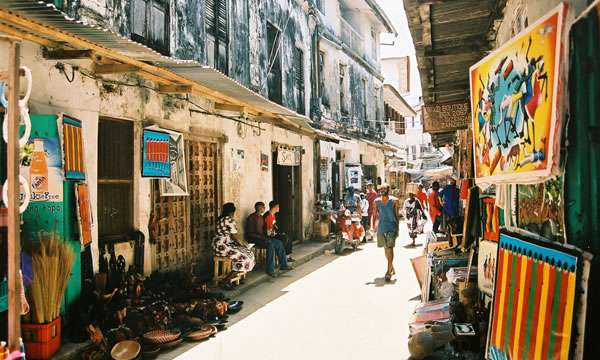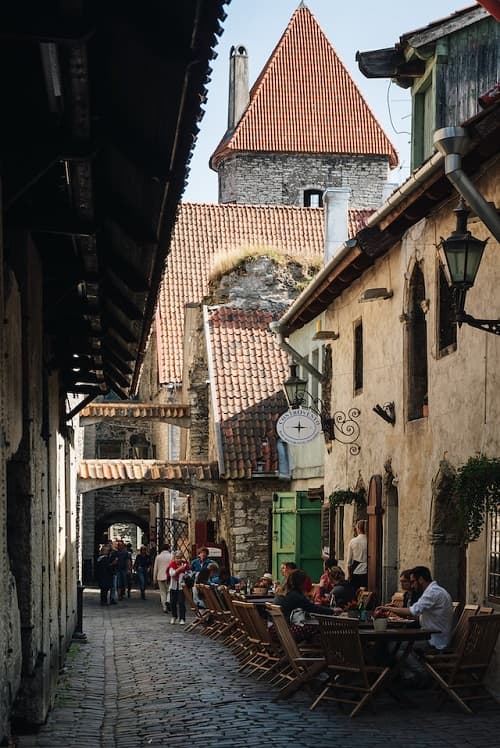Stone Town is the historic centre of Zanzibar’s capital: Zanzibar Town. It is one of the oldest surviving Swahili towns in eastern Africa and is the cultural heart of Zanzibar. That Stone Town is special is evidenced by the fact that it has been on the UNESCO World Heritage List since 2000.
The town’s buildings are a coming together of different cultures that all once lived there. It consists of a mixture of Persian, European, Arab and Indian construction. The Arab buildings are best recognised by the large wooden doors used there. Although there are also Indian buildings with these distinctive doors.

From the old part of the capital, spices used to be mainly exported. And until 1890, the Arabs used Stone Town as one of the main slave trading ports. Eventually, it was the British who put an end to human trafficking on the island.
Zanzibar Town is located on the western part of the island on a peninsula. The buildings in Stone Town are so densely built that it is not possible to drive through them by car.
Visit Stone Town
When you go to Zanzibar on holiday, a visit to Stone Town is a must on your to-do list. We recommend booking a guide who knows all the great spots in Stone Town so you don’t miss a thing. If you want to grab something to eat in the restaurants, it is a good idea to make a reservation in the afternoon so you are assured of a seat on one of the many rooftops.
Important buildings in Stone Town
Aga Khan Mosque – Zanzibar’s largest mosque
Dating back to 1828, the Aga Khan Mosque is located in the centre of Stone Town. It is one of the largest mosques in Zanzibar. The beautifully detailed mosque is clearly influenced by European movements. At the front of the mosque is a large courtyard.
Anglican Cathedral of Christ
This Anglican Cathedral was built in 1873 by Brit Edward Steere, on the site where Zanzibar’s largest slave market once was. It was the first Anglican cathedral built on Zanzibar. Its pointed tower and English architectural style make the church a real eye-catcher. On Sundays, there is a service in English.
Beit el Ajaib – The house of miracles
This impressive building is a true icon in Stone Town. Rumour has it that the doors of this building are the largest doors in East Africa. It was commissioned by Sultan Barghash in 1883 as a ceremonial palace and was also called House of Wonders. This is because it was the first building on Zanzibar with electric lighting, a lift and running water.
Darajani Bazaar
The shopping centre opposite the market on Darajani Road is Darajani Bazaar. This mall consists mainly of Chinese and Iranian imports. If you have planned a longer stay on Zanzibar, this is a great shopping centre to stock up on important items such as mosquito nets.
The gardens of Forodhani
Forodhani means customs and so this is where the customs office used to stand. The gardens were created in 1936 to commemorate the silver jubilee of Sultan Khalifa (1911 – 1960). In the evenings, this is a popular spot for locals and there will be stalls and rugs selling stuff. In the middle, there is a place where the army band plays its music. This is the place where tourists and locals meet.
The Palace Museum
The Palace Museum is the most recent Sultan’s palace from the Al Busid dynasty. The building houses a museum with many memorable objects and material from the Sultans’ history. During this visit, you will get an idea of how the sultans lived over the years.
The old fort
As the name suggests, the fort was built in 1700. This fort was used by the Portuguese and the Arabs. In the 19th century, the fort was used as a prison and transport place. Today, it is a cultural centre where music is made.
Hamamni Persian Baths
Hamamni Persian Baths were built by the Sultan’s son and served for public use. For a fee, anyone could use the baths. Unfortunately, the baths are no longer in use now. However, they have been fully restored making it well worth a visit.
High Court
This is the court of Zanzibar that has independent jurisdiction over Zanzibar. The Court of Tanzania only has jurisdiction over mainland Tanzania and therefore not Zanzibar.
Ithnashiri Dispensary
The building is among the most important buildings in Stone Town. The owner of Ithnashiri Dispensary was one of Zanzibar’s richest men and made it available as a hospital for the poor. On the top floor is a small museum where tells about the restoration of the building with old photos. On the ground floor you will find shops.
Kilele Square
The place where Zanzibar’s famous slave market was. Kilele means sound in Swahili so it is thought that the square was named during the slave market era. Around the square are important buildings such as the US consulate and the British consulate.
Malindi Mosque
This is one of the oldest mosque in Zanzibar. It was built by a Sunni sect in simple style. A special feature of the building is that the minarets are not built from the ground but on a square plateau.
Markets
In the centre of Creek Road, there are several markets such as the fish market, fruit market and meat market. All the exotic fruits and vegetables of the island can be found at this market. The buildings were built in the early part of the last century.
Peace Memorial Museum
This is Zanzibar’s national museum and features many artefacts from the island’s history. For example, the ancient drums and horns of the Alawi kings. A piece of the first railway and, of course, a lot of history about the slave trade.

Shakti Temple
Until 1964, the Shakti temple was a busy temple that was regularly full. The temple is always open to people and there is an opportunity for a guided tour.
St Joseph’s Catholic Cathedral
This cathedral was designed by a French architect who also designed the cathedral in Marseille. From the higher spots in stone town, the cathedral’s towers can be seen throughout the city. Except, of course, in the small/narrow streets.
Also read